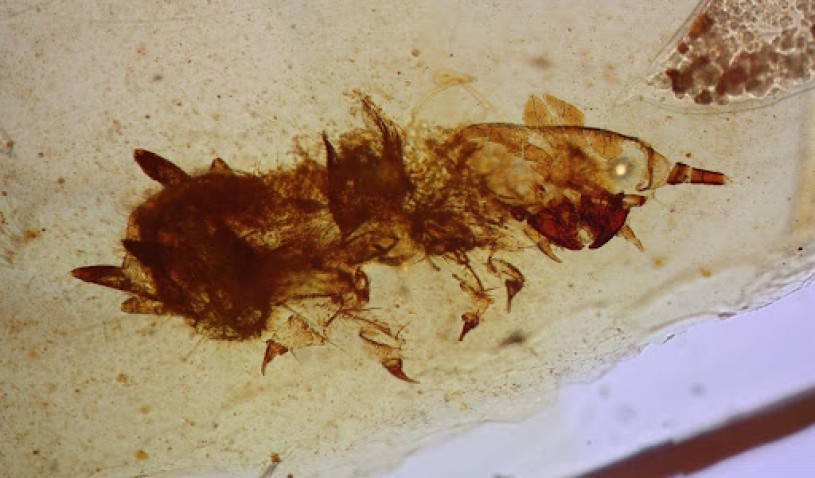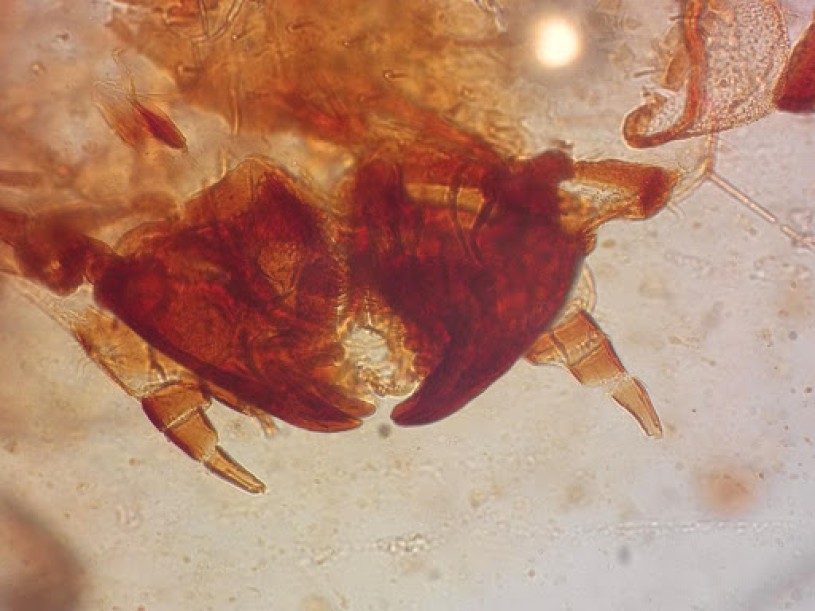Los Angeles, CA (April 19, 2023) — For hundreds of millions of years, vertebrates and arthropods have coexisted and interacted in various ways—yet evidence of those relationships is extremely rare in the fossil record. But new fossils found in Spanish amber have revealed that beetles fed on the feathers of dinosaurs about 105 million years ago, showing a symbiotic relationship of one-sided or mutual benefit, according to an article co-authored by Dr. Luis Chiappe, Senior VP, Research & Collections at the Natural History Museums of Los Angeles County (NHMLAC) and Gretchen Augustyn Director and Curator, Dinosaur Institute in Proceedings of the National Academy of Sciences of the United States of America today.
“Inclusions in amber allow us to peek into an ancient past that is rarely revealed by the typical fossil record,” Chiappe said. “This study offers tantalizing evidence about the beginnings of tree-nesting in dinosaurs, including birds."
The main amber fragments studied from the San Just area of Teruel, Spain contain larval molts of small beetle larvae tightly surrounded by portions of downy feathers. The larval molts were identified as relatives of modern skin beetles, which feed on organic materials that are hard for other organisms to decay, such as natural fibers. However, these beetles — known as dermestids — also play a key role in the recycling of organic matter such as feathers, hair and skin in nature, commonly inhabiting nests of birds and mammals.
These fossils provide hard evidence that the beetles almost certainly fed on the feathers, according to the study’s lead author Dr. Enrique Peñalver. The amber shows that beetle larvae lived among the fossilized feathers (likely in a nest) on or near the resin-producing tree that preserved the relationship for millions of years.
The downy feathers preserved with the beetle remains belonged to an unknown theropod dinosaur during the Early Cretaceous. However, while the dinosaur may have been a bird (since birds are also dinosaurs), the studied feathers did not belong to modern birds—as they appeared about 30 million years later in the fossil record, during the Late Cretaceous.
Three additional amber pieces containing beetle molts were also studied from other areas of Spain, with the most impressive, complete specimen found in an amber deposit of Rábago/El Soplao in northern Spain. According to co-lead author Dr. Ricardo Pérez-de la Fuente, it’s unclear whether or not the dinosaurs benefitted from the beetles feeding on its feathers—however, it likely wasn’t harmful to the dinosaurs at all.
The other researchers on the international and multidisciplinary team for this study come from organizations like the Geological and Mining Institute of Spain of the Spanish National Research Council, the Botanical Institute of Barcelona, the University of Barcelona, and the Institute for Research on Biodiversity, the Complutense University of Madrid, the ‘Parque de las Ciencias’ of Andalusia, the Autonomous University of Madrid, the Royal Academy of Exact, Physical and Natural Sciences, the American Museum of Natural History, the Senckenberg Research Institute and Oxford University Museum of Natural History.
About the Natural History Museums of Los Angeles County:
The Natural History Museums of Los Angeles County (NHMLAC) include the Natural History Museum, La Brea Tar Pits, and the William S. Hart Museum. They operate under the collective vision to inspire wonder, discovery, and responsibility for our natural and cultural worlds. The museums hold one of the world’s most extensive and valuable collections of natural and cultural history—more than 35 million objects. Using these collections for groundbreaking scientific and historical research, the museums also incorporate them into on- and offsite nature and culture exploration in L.A. neighborhoods, and a slate of community science programs—creating indoor-outdoor visitor experiences that explore the past, present, and future. Visit NHMLAC.ORG for adventure, education, and entertainment opportunities.

